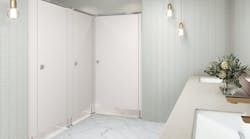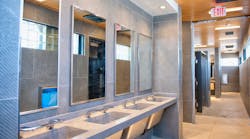In architecture, design is more than just aesthetics. It is about creating buildings and facilities that cater to the needs of everyone. Architects orchestrate spaces that inspire, serve, and uplift, while balancing designs to the realm of inclusivity, accessibility, and compliance.
An overlooked and crucial area to monitor for code and legislative changes are for baby and adult changing stations. In recent years, each of these product categories has experienced significant activity—from new legislation and updated standards to building codes. Below are examples of some common legislation that apply to baby and adult changing stations.
Too often, it is a struggle for families and care-givers of adolescents and adults with special needs or disabilities to find a dignified means of diaper changing in public.
The BABIES Act: Creating Family-Friendly Spaces
In 2016, the U.S. Congress enacted the BABIES Act, which mandates baby changing accommodations in male and female restrooms in federal buildings. This legislation reflects the growing emphasis on inclusivity and family support. Several other states, cities and municipalities have also enacted legislation requiring baby changing stations in public facilities. By adhering to the BABIES Act and other local legislation, public buildings enable all parents to be able to take care of their children.
ADA Compliance: Ensuring Inclusivity
Specifying baby changing stations that are compliant with the 2010 ADA Standards (ADAS) and the 2009/2017 International Code Council (ICC) A117.1 standards when properly installed is crucial to the goal of accommodating the needs of more people and ensures that public spaces can be accessed with dignity and ease.
Mandating Adult Changing Stations: Embracing Change
Restroom or special needs inclusivity extends beyond baby changing stations to adult changing stations. A number of states and the Canadian province of Ontario have passed legislation that requires adult changing stations in public and government spaces, Minnesota recently also joined this list in 2023. Many other states and local governments have passed or are currently considering similar legislation.
The International Code Council (ICC) approved Code E142-21 for the 2024 International Building Code (IBC). This code change requires adult changing stations to be provided in certain types of occupancies, including large assembly and mercantile facilities, college classroom buildings, and highway rest stops/service plazas. Beyond providing adult changing stations in public spaces, these changing stations should be height adjustable. Dedicated restrooms with height adjustable adult changing stations provide a much easier and safer changing experience for the cared for and cared giver.
As Architects, Your Role is More Important Than Ever
You are not just designing spaces. You are creating buildings that offer access to everybody, regardless of family status or disabilities. With the evolving landscape of codes and regulations, especially as it relates to accommodating the needs of families and caregivers, your role as advocates becomes even more vital. By staying informed about the latest codes, standards, and legislation, you can help ensure that your designs are inclusive and accessible for everyone.
For more information: koalabear.com



